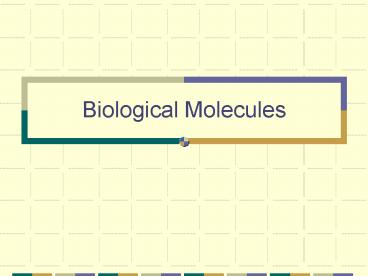Biological Molecules - PowerPoint PPT Presentation
1 / 26
Title:
Biological Molecules
Description:
Biological Molecules. Carbon based molecules (Organic) ... Biological Molecules 'Pimp my ride Biology' ... Act as biological catalysts. Increase the rate of ... – PowerPoint PPT presentation
Number of Views:770
Avg rating:5.0/5.0
Title: Biological Molecules
1
Biological Molecules
2
Lets clear up some terms
- Organic Molecules
- Biological Molecules
- Macromolecules
- Polymers
3
Polymers
- Poly many mer part. A polymer is a large
molecule consisting of many smaller sub-units
bonded together. - These sub-units are called monomers
4
Classes of Organic Molecules
Note Type of organic molecule depends on
monomers or building blocks that make them
- 1) Carbohydrates
- 2) Lipids
- 3) Proteins
- 4) Nucleic Acids
5
Biological Molecules
- Carbon based molecules (Organic)
- Think of this hoop ride as a carbon skeleton.
NOT VERY IMPRESSIVE!!
6
Biological Molecules
- Pimp my ride Biology
- Functional Groups things we can add to our
carbon skeleton to pimp it out.
7
Biological Molecules
- These new parts give our biological molecules
fancy new functions!!
8
Biological Molecules
- Functional Groups
- Hydroxyl Groups (-OH)
- Carbonyl Groups (CO)
- Carboxyl Groups (COOH)
- Amino Groups (C-NH2)
- Sulfihydryl Groups (C-SH)
- Phosphate Groups (PO42-)
9
Carbohydrates
- Include carbon, hydrogen, and oxygen (C, H, O)
- H and O in a 21 ratio
- Includes sugars and starches
- Classified according to size
- Monosaccharide
- Disaccharide
- polysaccharide
10
Carbohydrates
- Monosaccharides
- Simple sugars (one sugar)
- Building blocks (monomers)
- 121 CHO ratio
- Ex deoxyribose (DNA), glucose, galactose,
fructose, ribose
glucose
11
Carbohydrates
- Disaccharides
- Double sugars (2)
- 2 monosaccharides joined together
- Ex
- Sucrose glucose fructose (table sugar)
- Lactose glucose galactose (milk)
- Maltose glucose glucose (malt sugar)
sucrose
12
Carbohydrates
- Polysaccharides
- Polymers (made up of 3 or more monomers)
- Long chain of simple sugars
- Used for energy storage
starch
13
Functions of Carbohydrates
- FUEL (ENERGY)!!!!
- Glucose breaks down and releases energy from ATP
- If ATP supplies are good and energy is not needed
or energy needs are satisfied, excess
carbohydrates are stored - Glycogen
14
Lipids
- Insoluble in water
- Dissolve in other lipids
- Contain C, H, O (C and H will largely outnumber
the O) - 3 types
- Neutral fats
- Phospholipids
- Steroids
15
Lipids
- Neutral Fats
- Fats and oils
- Composed of glycerol and 3 fatty acids
- E shaped
- Two types
- Saturated single bonds between carbons
- Exist as solids
- Unsaturated one or more double bonds between
carbons - Exist as oils (liquid)
16
Lipids
- Phospholipids
- Contain phosphorus
- Tail is nonpolar (hydrophobic)
- Head is polar (hydrophilic)
17
Lipids
- Steroids
- Four hydrocarbon (C and H) rings
- Cholesterol essential for life!!
- Major component of cell membranes
18
Proteins
- Basic structural material of the body
- Contain carbon, hydrogen, oxygen, and nitrogen
(C, H, O, N) - Made up of amino acids
19
Proteins
- Amino acids
- Building blocks (monomers) of proteins
- 20 types
- Order they are arranged in determines their
structure and function - Primary structure
- amino acid amino acid amino acid
- Beads of a necklace
20
Proteins
- Amino acids (continued)
- Secondary structure
- Coil or twist primary structure into a folded or
helix shape - Tertiary structure
- Helix folds on itself into a ball or globular
molecule - Quaternary structure
- More than one amino acid chain
21
Proteins
22
Proteins
- Enzymes
- Act as biological catalysts
- Increase the rate of chemical reactions
- Lowers activation energy
- Energy needed to start a reaction
23
Nucleic Acids
- Composed on nucleotides (monomers)
- Contain carbon, hydrogen, oxygen, nitrogen, and
phosphorus (C, H, O, N, P) - Two types
- DNA and RNA
24
Nucleic Acids
- Nucleotide 3 parts
- Nitrogen containing base
- Adenine (A)
- Guanine (G)
- Cytosine (C)
- Thymine (T)
- Uracil (U)
- Pentose sugar
- Phosphate group
25
Nucleic Acids
- DNA
- Deoxyribonucleic Acid
- Found in the nucleus of a cell
- Contains genetic material
- Replicates (copies) before cell division
- Carries instructions for all protein synthesis in
the body - Double strand
26
Nucleic Acids
- RNA
- Ribonucleic Acid
- Found outside the nucleus
- Carries out orders from DNA for making proteins
- Single strand






























